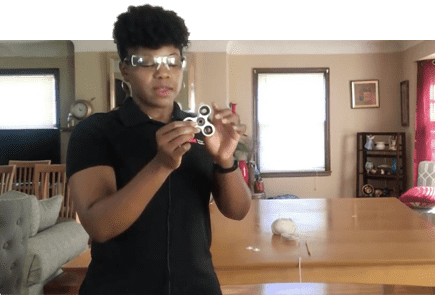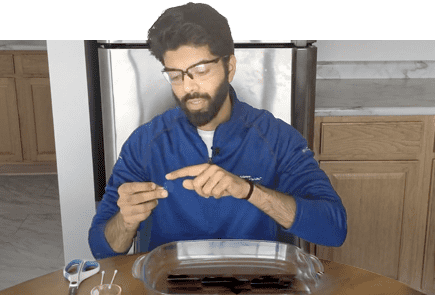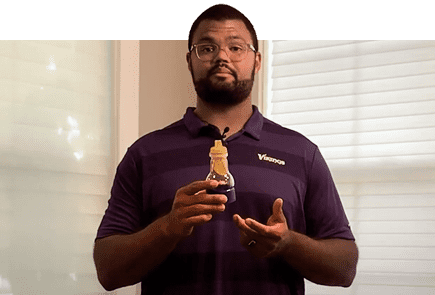Join 3M Scientist Jeff Payne as he uses nothing more than milk, dish soap, and a few other kitchen supplies to get the amazing effects of fireworks without using any fire at all.
Background
The structure of soap molecules enables them to remove dirt with ease, as well as move around oily particles. They consist of a hydrocarbon chain with an atom at the end. The hydrocarbon end is attracted to oil and repels water, whereas the other end attracts water. This can create all sorts of interesting effects in practice. Using the materials below, see if you can create a pop of color on your kitchen table.
Key Concepts
- Molecular interaction
Materials
- An adult helper
- Bowl or Saucer
- Milk
- Food Coloring
- Cotton Swab
- Liquid soap (dish soap or hand soap)
Preparation
- Fill the bowl about halfway full of milk.
- Drop 3-4 drops of food coloring near the center. You can use one color or several colors, just try not to mix them together.
- Cover one end of the cotton swab with liquid soap.
- Make a prediction. What is going to happen when the soap and the milk mix together?
- Take the cotton swab and gently place it in the center of the food coloring. Don't mix or stir, just watch what happens.
- Try moving the cotton swab to different parts of the bowl. Does it work differently on the edge than in the middle? Does the soap stop working eventually? Do the patterns look the same every time?
- Be sure to clean up when you are done. Pour the liquid mixture down the sink and rinse it down the drain. Wash the bowl or saucer. Throw away the cotton swab, and put the other materials back where you found them.
Observation and Results
Why did the food coloring push away from the cotton swab? Milk has fat and water in it, and fat does not dissolve in water. Soap is made up of special molecules that can interact with both fat and water, so when the soap starts to connect to the fat molecules in the milk, it allows them to dissolve in water and be moved around. The soap molecules are looking for fat molecules to join with, and as they move through the milk, they push the food coloring around. This eventually stops happening because all of the soap molecules find fat molecules to connect to, and they don't need to move around anymore. This is why dish soap is so effective at getting grease and oil off dishes. The soap molecules attach to grease molecules and allow them to be more easily dissolved in water, so they can wash right down the drain.
If the fat in the milk is what makes this happen, do the results change if you try milk with different amounts of fat? For example, instead of whole milk, can you use skim milk, or 2%, or 1%? What about creamer? What else do you have that is made with milk and can be a liquid?
Milk is great because the white background makes it easy to see the food coloring, but does it have to be milk, or can you use other liquids, or even combine other liquids? Keep in mind that not all liquids around the house are safe, so always check with an adult before using. Be especially careful if you want to use a liquid you wouldn't drink.
Do you think there might be anything other than dish soap you could use to create the same effect? If you find options that work better or worse, can you come up with or research reasons why they are better or worse?
Lastly, what about the cotton swab? See if you can think of other ways to add the dish soap. What if you add it in two or more spots at the same time?
Bonus: food coloring works great as a visual display, but feel free to get creative. You can probably come up with other ways to show that the milk is moving.
Safety First and Adult Supervision
- Follow the experiment’s instructions carefully.
- A responsible adult should assist with each experiment.
- While science experiments at home are exciting ways to learn about science hands-on, please note that some may require participants to take extra safety precautions and/or make a mess.
- Adults should handle or assist with potentially harmful materials or sharp objects.
- Adult should review each experiment and determine what the appropriate age is for the student’s participation in each activity before conducting any experiment.
Next Generation Science Standard (NGSS) Supported - Disciplinary Core Ideas
This experiment was selected for Science at Home because it teaches NGSS Disciplinary Core Ideas, which have broad importance within or across multiple science or engineering disciplines.
Learn more about how this experiment is based in NGSS Disciplinary Core Ideas.
Engineering Design (ETS)1: Engineering Design
Grades K-2
- 2-PS1-1. Different kinds of matter exist and many of them can be either solid or liquid (or gas).
- 2-PS1-2. Different properties are suited to different purposes.
Grades 3-5
- 5-PS1-1. Matter of any type can be subdivided into particles that are too small to see but even then, the matter still exists and can be detected by other means.
Grades 6-8
- MS-PS1-1. Substances are made of different types of atoms, which combine with one another in various ways. Atoms form molecules that range in size from two to thousands of atoms.
- MS-PS1-4. Gases and liquids are made of molecules or inert atoms that are moving about relative to each other. In a liquid, the molecules are constantly in contact with others.
Grades 9-12
- HS-PS1-1. Each atom has a charged substructure consisting of a nucleus, which is made of protons and neutrons surrounded by electrons.
- HS-PS1-3. The structure and interactions of matter at the bulk scale are determined by electrical forces within and between atoms.
Grades 3-5
- 5-PS1-4. When two or more different substances are mixed, a new substance with different properties may be formed.
- 5-PS1-2. No matter what reaction or change in properties occurs, the total weight of the substances does not change.
Grades 6-8
- MS-PS1-7. Substances react chemically in characteristic ways. In a chemical process, the atoms that make up the original substances are regrouped into different molecules and these new substances have different properties from those of the reactants.
- MS-PS1-5. The total number of each type of atom is conserved, and thus the mass does not change.
- MS-PS1-6. Some chemical reactions release energy, others store energy.
Grades 9-12
- HS-PS1-5. Chemical processes, their rates, and whether or not energy is stored or released can be understood in terms of the collisions of molecules and the rearrangements of atoms into new molecules, with consequent changes in the sum of all bond energies in the set of molecules that are matched by changes in kinetic energy.
- HS-PS1-7. The fact that atoms are conserved, together with knowledge of the chemical properties of the elements involved, can be used to describe and predict chemical reactions.
Grades K-2
- K-PS2-1. Pushes and pulls can have different strengths and directions.
- K-PS2-2. Pushing or pulling on an object can change the speed or direction of its motion and can start or stop it.
Grades 3-5
- 3-PS2-1. Each force acts on one particular object and has both strength and a direction.
Grades 6-8
- MS-PS2-1. For any pair of interacting objects, the force exerted by the first object on the second object is equal in strength to the force that the second object exerts on the first, but in the opposite direction.
Grades 9-12
- HS-PS2-1. Newton's second law accurately predicts changes in the motion of macroscopic objects.
Grades K-2
- K-PS2-1. When objects touch or collide, they push on one another and can change motion.
Grades 3-5
- 3-PS2-1. Objects in contact exert forces on each other.
- 5-PS2-1. The gravitational force of Earth acting on an object near Earth’s surface pulls that object toward the planet’s center.
Grades 6-8
- MS-PS2-4. Gravitational forces are always attractive. There is a gravitational force between any two masses, but it is very small except when one or both of the objects have large mass.
Grades 9-12
- HS-PS2-6. Attraction and repulsion between electric charges at the atomic scale explain the structure, properties, and transformations of matter, as well as the contact forces between material objects.
Explore Additional Science at Home Videos and Activities

Fidget Spinner
Your teacher might not love when you have one in class, but the physics behind fidget spinners are truly head-spinning!
Join 3M scientist Tesha R.-Alston Dampier as she shows you how a spinning motion changes the way things move.

Soap Boat
Join 3M Researcher Vasav Shani as he introduces you to the science of surface tension.
Not only is it only important for many engineering and earth science processes, it also makes blowing bubbles possible.

How Do We Breathe?
How do our lungs work?
Follow along as special guest Dakota Dozier, an offensive lineman for the Minnesota Vikings, makes a model to show how air flows in and out of the lungs with ease.

